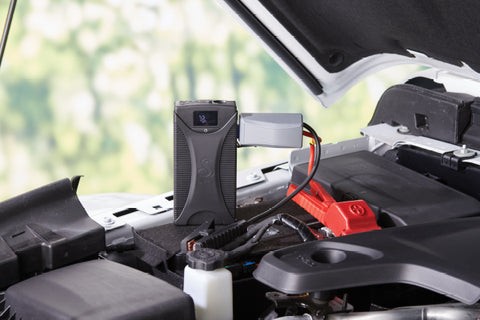Experiencing a dead car battery is a common and frustrating situation for drivers. Whether it’s due to leaving your headlights on, cold weather, or simply an aging battery, a car that won’t start can disrupt your day. While jumper cables are a standard recommendation for automotive safety, they require another vehicle to be effective. This is where portable car jump starters become invaluable. Devices like the Cobra Jump Starter 800A and 1000A offer a quick and safe solution, allowing you to jump start your car independently, without waiting for roadside assistance or relying on the help of strangers.
Portable jump starters utilize high-current lithium-ion batteries to deliver the necessary power to crank your engine. These batteries are rechargeable and designed for long-term storage, typically holding a charge for over a year, unless frequently used. Many jump starters can provide multiple jump starts on a single charge, and some even double as portable power banks for charging electronic devices like smartphones and tablets. They are designed to efficiently jump start both gasoline and diesel engines in cars and light trucks, addressing common dead battery scenarios caused by cold temperatures, lights left on, or infrequent vehicle use.
Step-by-Step Guide: How to Jump Start Your Car
The exact procedure for using a portable jump starter can vary slightly depending on the model. Always prioritize reading and adhering to the manufacturer’s instructions for safe and effective operation. The following steps are based on the Cobra Jump Starter 800A and 1000A models and are generally applicable to most battery-powered jump starters. However, always consult your specific product manual before use.
Method 1: Direct-to-Battery Jump Start
This is the most common and direct method for jump starting your car using a portable jump starter.
- Connect the Jumper Cables: Attach the jumper cable clamps directly to your car battery terminals. First, connect the red clamp to the positive (+) terminal. Then, connect the black clamp to the negative (-) terminal. Ensure a firm and secure connection.
- Connect to the Jump Starter: Plug the other end of the jumper cables into the designated port on your portable jump starter.
- Wait for the Ready Signal: Wait for the green LED indicator light on the jumper cable to illuminate. This signals that the jump starter is properly connected and ready to deliver power.
- Start Your Vehicle: Once the green light is on, attempt to start your car’s engine. Turn the ignition key or press the start button as you normally would.
- Disconnect in Reverse Order: After your car has started, disconnect the jumper cables in reverse order of connection. First, disconnect the cables from the jump starter, then remove the black clamp from the negative terminal, and finally the red clamp from the positive terminal of your car battery.
Important Note: If your vehicle fails to start after a few attempts, the jump starter may automatically shut off or enter a “recovery mode” to prevent overheating. This can occur if the car battery is excessively drained or if there is another underlying issue preventing the car from starting.
Method 2: In-Vehicle Jump Start (12V Accessory Port)
Certain jump starters, including the Cobra Jump Starter 1000A, offer the convenience of jump starting your car through the 12V accessory port (cigarette lighter socket) inside your vehicle. This method can be particularly useful in adverse weather conditions or when you prefer to remain inside your car for safety.
- Prepare Your Vehicle and Jump Starter: Turn off all car accessories (headlights, radio, etc.). Connect the 12V jumper cable to your portable jump starter.
- Accessory Mode: Turn your car’s ignition switch to the “Accessory” position. For vehicles with a start button, press the START button without pressing the brake pedal to enter accessory mode.
- Connect to 12V Port: Plug the 12V jumper cable into your car’s 12V accessory port (cigarette lighter socket).
- Wait for “Output Ready”: Allow the jump starter to establish a connection and begin charging. For the Cobra 1000A, wait until the display indicates “Output Ready” and shows 5 solid charging bars. This process can take up to 15 minutes.
- Start Your Vehicle: Once the jump starter indicates it’s ready, attempt to start your car’s engine as usual.
- Disconnect: After the car starts, disconnect the 12V jumper cable first from the accessory port inside your car and then from the portable jump starter.
If your car still doesn’t start after using the in-vehicle method, try the direct-to-battery method for a more powerful jump start.
Post Jump Start: It’s crucial to drive your vehicle for at least 20 minutes after a jump start to allow the car’s alternator to recharge the battery.
Jump Starter Maintenance: Recharge your portable jump starter fully after each use, especially after jump starting multiple vehicles. Even if not used, recharge it at least every 12 months to maintain optimal battery performance. Cobra jump starters often include a status indicator for easy monitoring of battery charge level.
Are Car Jump Starters Safe to Use?
Yes, when used according to the manufacturer’s instructions, portable jump starters are a safe and highly convenient tool for dealing with dead car batteries. They eliminate the need for external assistance, providing independence and peace of mind in emergency situations. Furthermore, in situations where another vehicle cannot easily access your battery terminals due to parking constraints, a personal jump starter becomes particularly valuable.
Safety Precautions:
- Charge Level: Always ensure your jump starter is fully charged before use.
- Inspect Equipment: Check all cords and plugs for damage before each use.
- Avoid Damaged Devices: Never use a jump starter that is damaged, modified, submerged in water, or exposed to excessive moisture.
- Flammable Environments: Do not use jump starters in areas with flammable fumes or gases, near open flames, or sparks.
Troubleshooting: If your car fails to start even after using a fully charged jump starter, the issue might be more than just a dead battery. It could indicate a completely dead or damaged battery, or problems with your starter, alternator, or other components. In such cases, it’s advisable to consult a qualified mechanic to diagnose and address the underlying issue.
In conclusion, a portable car jump starter is an incredibly useful tool for personal vehicle emergencies and even for assisting other drivers in need of a quick jump start. It provides a reliable and safe solution for getting back on the road quickly when faced with a dead car battery.

